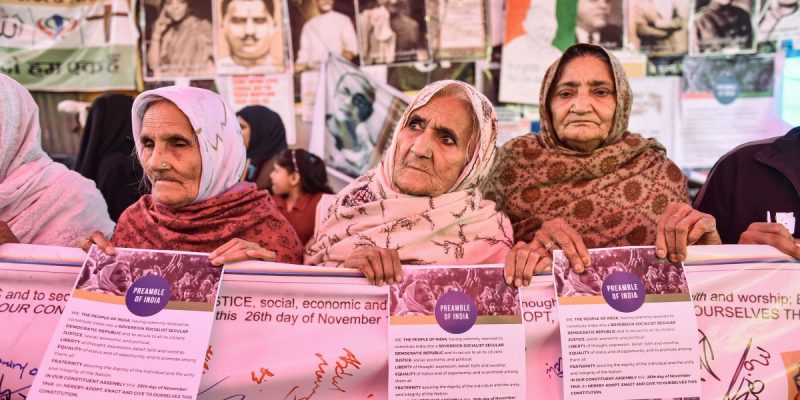The home and the world are usually portrayed as binaries. Women, in such projections, are homemakers. Men inhabit the world outside.
Recent sit-in protests by thousands of women, many of them homemakers, against the new citizenship law, have dissolved this perceived boundary. Women have transformed streets into homes. For over two months, women protesters – many among them mothers and grandmothers – have been sitting in the streets of Delhi’s Shaheen Bagh. Women have also been camping at Kolkata’s Park Circus maidan for more than a month, as elsewhere around the country.

In this existential battle, with its high stakes, there are no separate realms for women and men. When the ground starts to move under your feet, you take extraordinary leaps of resolve and courage. As Jamil, a protester at Park Circus maidan told Kavita Panjabi, “If a housewife steps out then something extraordinary has happened, something really terrible has happened. Hindustaan ki sarzameen, the land of Hindustan, Hindustaan ki mitti, the very soil of Hindustan, beckons us in its sorrow.” Jamil has been coming to the protest site with 18 family members.
The transition from home to the world – from being a stay-at-home mother to a political catalyst – has been nothing but organic in these cases. One could ask: what other option did they have? The threat of being rendered homeless, the shadow of disenfranchisement refusing to lift, warranted a response like none other in post-Independent India. At the Park Circus maidan protest site, you meet women who, prior to this critical moment, barely travelled any significant length of distance outside their homes. Today, they sit out late into the night. Alongside them are college-going women and teachers. Some live in the nearby mohallas, others come from a distance.
It is to these women that this International Women’s Day belongs. Women, who till yesterday, were invisibilised by the political system, patriarchal family and social structures. For over a decade, women’s organisations have unsuccessfully mounted pressure on the political class to pass the women’s reservation bill to ensure 33% representation of women in Parliament and state assemblies. Political parties simply did not allow the legislation to go through. Even those ostensibly supporting the Bill only paid lip-service to it. Meanwhile, legislations guaranteeing quotas for Other Backward Classes (OBCs) were passed without a fuss. The Bharatiya Janata Party (BJP) government which, five years ago, came to power with such a huge majority, barely mentions the women’s reservation Bill.
If the political class, wilfully or otherwise, has excluded women from public political spaces, the Citizenship Amendment Bill (CAA) and the home minister’s emphasis on the “chronology” of the Act and the National Registry of Citizens (NRC) have foiled that plan. Suddenly, women are appearing in all kinds of public spaces. Cocking a snook at elected representatives, the ‘invisibilised’ are now occupying these spaces. The novel, mass visibility of women – particularly the assertion by Muslim women, the exposure of other communities to the Muslim dominated mohallas – infuses this March 8 with a new political, social, and gender dynamic. Women are saving their homes by embracing the world outside.
Also Read: The Brave Women of Shaheen Bagh
The spontaneous manifestation of outrage and, equally, the determination to stay in the fight is clearly distinct from political party-led movements. In stark contrast to those mobilisations, which are generally and overwhelmingly led by men, women are in charge here. This organic process of change – not just a spatial transformation but a reversal of gender roles within homes as well – is remarkably noticeable at the protest sites. While women attend the sit-in, many men look after children at home, distribute food among the protesters, and keep the sites clean.
This may be a good moment to recall the historical roots of March 8. The impetus came from New York City in 1908. Thousands of striking garment workers marched through the city demanding higher wages and better working conditions. Such historic events often slide into routine affairs. The essence of the moment forgotten, such celebrations become profit garnering market-driven projects. This day and that. Consumers remain unaware of the histories of these events, the significance of their origins. Celebrations on March 8, regrettably, have become another such instance of ritual observation. In his decision to hand over his social media accounts to “inspiring women” on International Women’s Day, Prime Minister Narendra Modi has taken such gimmicks to a new height.
One may remind the prime minister that the “inspiring women” are sitting outside, braving the winter chill and sudden downpours. They are fighting for their right to exist.

